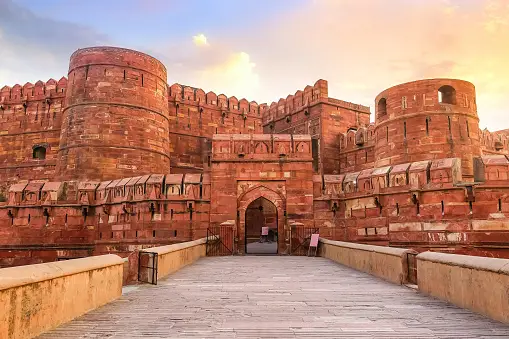- Private car and driver in Delhi / India
- +91-8447445445
- info@discoverindiabycar.com sugar.ankit@yahoo.com
 +91-9818434712
+91-9818434712
Agra
Agra is a city in the Indian state of Uttar Pradesh, about 230 kilometres (140 miles) south of the national capital New Delhi and 330 kilometres west of the state capital Lucknow. Agra is the fourth most populous city in Uttar Pradesh and the twenty-third most populous city in India, with a population of approximately 1.6 million people.
Climate
The metropolis has heat winters, warm and dry summers and a monsoon season. The hot westerly wind, Loo, blows mainly in April, May and June with great intensity and can cause fatal heatstroke. Monsoon rains usually begin in the first week of July; and usually ends in mid-September. However, the monsoon, although substantial in Agra, is not as strong as the monsoon in other parts of India. The weather warms up in mid-October.
Location
The area around Agra is mostly plain with hills on the southwestern edge. The Yamuna and Chambal rivers run through the area. The area is also irrigated by the Agra Canal. Agra is about 210 km from the state capital New Delhi (via the Yamuna highway), about 336 km from the state capital Lucknow via the Agra-Lucknow highway and about 227 km from Kanpur via the Agra highway- Lucknow Highway. The average altitude of the city is 170 meters above sea level.
History of Agra
Agra’s notable historical period began during the reign of Sikandar Lodi, but the city’s golden age began with the Mughals. Agra was the capital of the Mughal Empire and the most important city on the Indian subcontinent under Mughal emperors Babur, Humayun, Akbar, Jahangir, and Shah Jahan. Agra became a centre for learning, arts, commerce, and religion under Mughal rule, and saw the construction of the Agra Fort, Sikandra, and Agra’s most prized monument, Shah Jahan built the Taj Mahal as a mausoleum for his favourite empress. With the fall of the Mughal empire in the late 18th century, the city passed first to the Marathas, then to the East India Company. Following independence, Agra evolved into an industrial town with a thriving economy. Tourism, as well as footwear, leather, and other manufacturing industries UNESCO World Heritage Sites include the Taj Mahal and the Agra Fort. The city is known for its Mughlai cuisine and has mild winters, hot and dry summers, and a monsoon season. The Golden Triangle tourist circuit, which includes Delhi and Jaipur, as well as the Uttar Pradesh Heritage Arc, which includes Lucknow and Varanasi, include Agra.
How to Travel Agra?
You can go to One Day Agra Tour by car with driver from Delhi. Discover India By Car offers the best tour packages for Agra. Some of the best tour packages for Agra with private car and driver is Golden Triangle Tour and Delhi to Agra by car explore India with Discover India by car.
Places to Visit in Agra
TAJ MAHAL
The Taj Mahal, one of the world’s seven wonders, is located in Agra on the banks of the River Yamuna. It was constructed as a memorial for Mughal Emperor Shah Jahan’s third wife, Mumtaz Mahal. It also houses Shah Jahan’s tomb. Taj Mahal, built entirely of white marble in the 17th century, is one of the world’s most beautiful monuments. Every year, more than the entire population of Agra passes through the magnificent gates to catch a glimpse of this breathtaking monument!


Fatehpur Sikri
Fatehpur Sikri is a town in the Agra district and a popular tourist attraction located 40 kilometres from Agra. Fatehpur Sikri, a city primarily made of red sandstone, was founded in 1571 by Mughal Emperor Akbar. It is a fortified city built by the king that served as the capital of his Empire for fifteen years. It is now a UNESCO World Heritage Site and is home to many famous monuments such as Jodha Bai’s Palace, Jama Mosque, Buland Darwaza, and Tomb of Salim Chisti. The Imperial Complex, inspired by Arab and Central Asian tent encampments, is a work of pavilions arranged in formal geometry on a plot of land.
AGRA FORT
The Agra Fort is a UNESCO World Heritage Site. It is also known as Lal Qila, Fort Rouge, or the Red Fort of Agra. It is approximately 2.5 kilometres northwest of the famous Taj Mahal. Emperor Akbar began the construction of the massive red sandstone fort on the banks of the Yamuna river.


Itimad-ud-daulah's Tomb
Queen Noor Jahan built this tomb for her parents in the Persian Garden, nestled on the bank of the river Yamuna. It was built of yellow marble with black and white marble inlay and was thus known as the Baby Taj.








